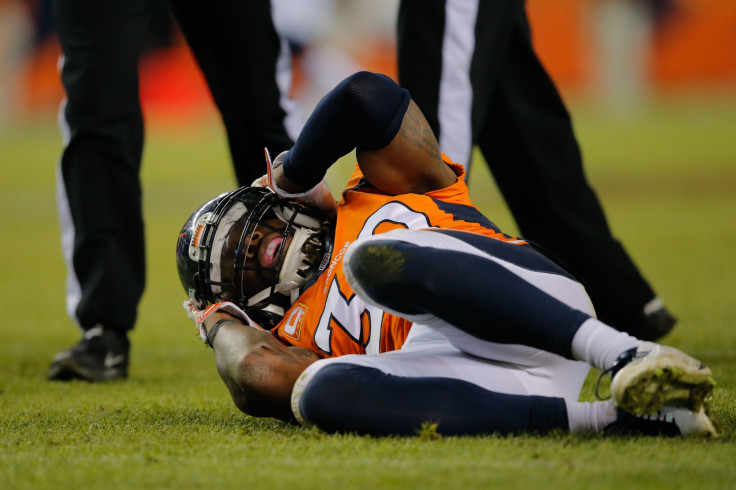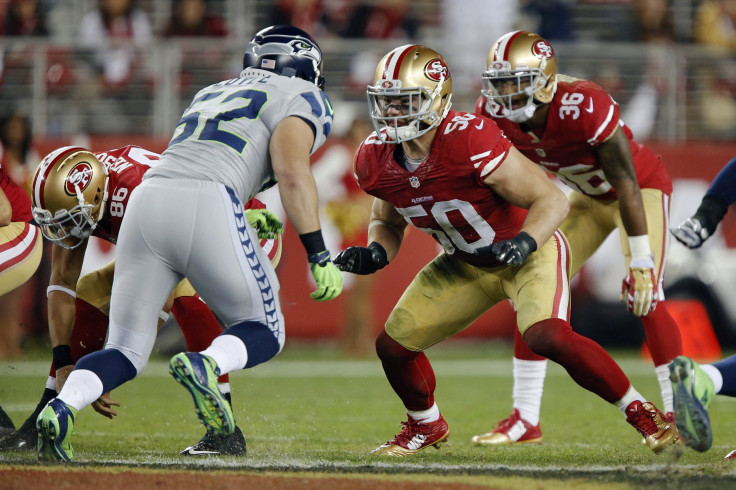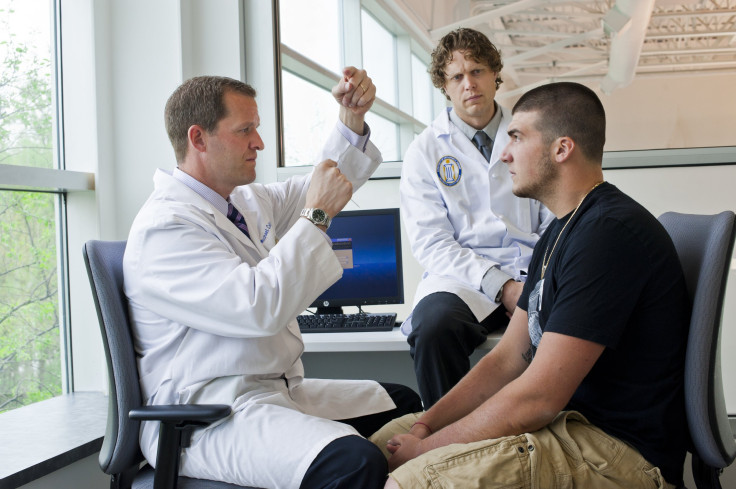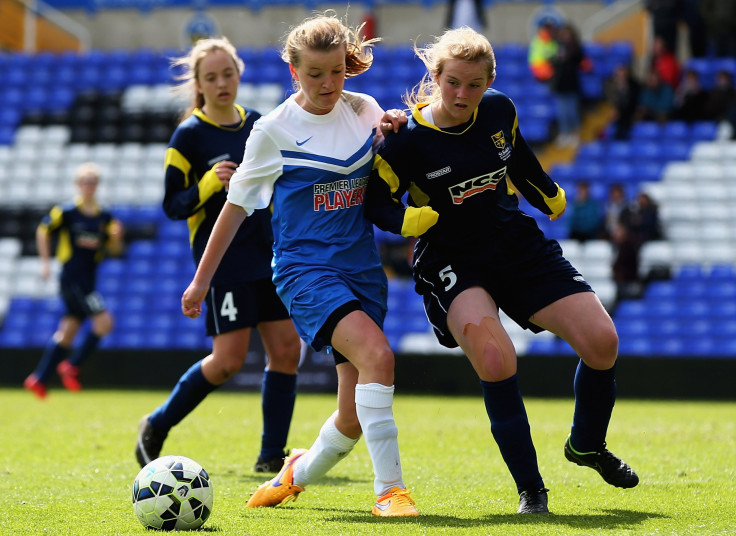NFL Underwrites Scientific Meeting To Set National Agenda For Concussion Treatment

Dozens of the nation’s leading medical experts will fly to Pittsburgh on the National Football League’s dime this week to decide on a better way to treat one of the most common injuries in sports: concussions. The gathering Thursday and Friday at the University of Pittsburgh Medical Center is intended to shape the future of concussion treatment for every athlete in the United States, from youth leagues to professional sports.
Researchers will wrestle with the question of whether doctors can actively treat concussions rather than simply allow patients time to heal. But this major scientific meeting also poses an even deeper quandary: Can doctors objectively agree on a national concussion treatment plan at a meeting funded entirely by the nation’s wealthiest sports league — one with a checkered history of the injury’s management?
The NFL has spent more than $100 million to fund concussion research and prevention in the last five years, and the league's largesse will loom large over the invitation-only gathering. Many of the meeting's attendees have received research money from the league or work for its teams. In addition, NFL Senior Vice President Jeff Miller told International Business Times that he will be there to observe.
And yet, the league's sponsorship has not been obvious from official announcements. The NFL funding was disclosed in an early press release UPMC issued in August about the meeting but not in a more recent announcement or media invitation. The University of Arkansas published a press release touting the attendance of one of its experts but omitting the league's sponsorship.
"The league has financial interests in this question. It has a financial interest in their players being able to play and the game being played a certain way," said Josephine Johnston, director of research and a bioethics expert at the nonprofit Hastings Center. "At the very least, something like that ought to be really transparent. You'd expect it to be transparent in the announcements about the meeting."
Critics have attacked the NFL for long ignoring the dangers concussions pose to its athletes, and accused its affiliates of playing down the risks in the past. Earlier this year, UPMC researcher Dr. Joseph Maroon, who will attend the meeting, said during a televised NFL Network appearance that concerns about long-term brain damage from football were "exaggerated." He later failed to disclose the full extent of his long relationship with the league when he published a study on those risks. The journal was forced to issue a correction.
The scientific and clinical stakes are high because the meeting is intended to set a new precedent in concussion treatment. Practically every athlete who has suffered a concussion in the past 20 years has gotten the same treatment advice: Go home and rest. But a growing number of influential researchers now say permitting concussed patients to exercise lightly from the earliest stages of recovery — a practice long assumed to be more harmful than helpful — might help them recover sooner.
Now, the league says it is particularly interested in managing concussions more effectively, and so it is paying for 35 researchers and clinicians to attend the Pittsburgh meeting. The meeting is closed to the media, the public and to researchers who were not invited, though the group plans to publish a white paper in the journal Neurosurgery.
"I don't think they're going to try to distort or influence what consensus opinions are, but talk to me after the meeting is over," said Dr. Robert Cantu, a neurosurgeon at the Boston University School of Medicine.
It was also in Pittsburgh that forensic pathologist Dr. Bennet Omalu detected the first evidence of chronic traumatic encephalopathy, a rare degenerative brain disease, in the brain of a former NFL player, Steelers linebacker Mike Webster, in 2002. The disorder is thought to result over the long term from repeated hits to the head, which may include concussions or even lighter hits that rattle a player but don’t cause a discernible injury.
Stories of Webster and others fueled 5,000 former players to sue the NFL for medical problems that result from repeated head trauma. The league settled last spring, offering $5 million to cover medical costs for those problems to every former player.

Since then, the league has invested at least $100 million into concussion efforts, estimates Dr. Richard Ellenbogen, a neurosurgeon at the University of Washington in Seattle who will also attend the meeting. Ellenbogen is co-chair of the NFL’s Head, Neck and Spine Committee and has been tapped to lead a new UW Sports Health and Safety Institute created through a $2.5 million NFL grant.
The influx of money has meant that today's athletic trainers have greater access to diagnostic and prevention tools than ever before. Coaches, athletes and parents are more aware of the risks and symptoms. But little has changed about the way doctors actually treat the concussion.
“Awareness from concussion has never been greater, and awareness with no solution is called hysteria,” said Dr. Micky Collins, a neuropsychologist and leading expert in concussion treatment at the University of Pittsburgh Medical Center. “We need to shift from awareness to active treatment and rehabilitation.”
Researchers still don't understand exactly what happens to the brain when a concussion takes place, but David Hovda, director of the UCLA Brain Injury Research Center, found some of the earliest clues in the 1990s. There is no bruising or swelling. Instead, he found the injury causes the outer covering or membrane of nerve cells in rats to become more permeable. This membrane regulates the flow of chemicals in and out of cells, and such a disruption quickly floods the brain. The sudden influx is thought to overwhelm receptors and induce symptoms such as dizziness, blurred vision and trouble with balance. It takes time and energy for the brain to naturally reverse these changes, though some researchers now think new therapies can hasten the process and shorten recovery.
Hovda also famously helped to discredit a series of scientific papers published by an NFL committee led by Dr. Elliott Pellman, a rheumatologist with little experience in brain research, that downplayed the potential harms of concussions for more than a decade. Hovda will not attend the meeting, though, and wasn't aware that it was happening until he was asked to comment on it for IBTimes. He burst out laughing, amused by the fact that NFL officials hadn't thought to fill him in when they visited his office to discuss his research just a few weeks ago.
"I am not invited to anything by the NFL," he says. "I think if I wanted to be a little cynical, I'd say ... the NFL has got an image problem and they've got to try to do something."
A New Precedent
American athletes suffer between 1.6 million and 3.8 million concussions each year, according to the Centers for Disease Control and Prevention. Most of them are simply told to rest and avoid stimulating activities such as video games, television, reading and even schoolwork for young athletes.
Dr. Rob Heyer, a team physician with the Carolina Panthers and the Carolinas HealthCare System and president of the NFL Physicians Society who will be in Pittsburgh for the meeting, says about 80 percent of patients recover within three weeks with this approach. But many athletes are eager to return to the game sooner. Some take months to recover and these patients often fall behind in school.
Lately, the league has closely watched and begun to fund Collins' work at the University of Pittsburgh Medical Center. He leads one of the largest sport concussion treatment programs in the country with a staff of 25 that treats 18,000 patients a year.
NFL officials toured Collins’ clinic a few years ago along with other programs around the country in search of promising concussion treatments. Collins was already well known in the sports concussion field for creating the ImPACT assessment — a leading concussion diagnostic test that his company has since sold to hundreds of high schools and youth sports leagues, as well as the NFL.
“If somebody really needed to get better, I would suggest that they go to Pittsburgh because I know they're going to get the best care there,” said Dr. Stephen Rice, a pediatrician at Jersey Shore Medical Center in Neptune, New Jersey.
After the visit, Collins and the league began discussing the value of a meeting to set the path forward for concussion treatment. The NFL quickly signed on.

Now Collins is attempting to rewrite the old rules of concussion treatment. At UPMC’s clinic, he greets new patients with the idea that a concussion is not a single injury. “Concussions are like snowflakes,” he says. He examines each patient and classifies their concussion into one of six types based on which of their symptoms are most likely to persist longer than a week: ocular, vestibular, cognitive, anxiety, migraine and cervical.
Then, he and his staff lead the patient through a customized set of therapies that match his particular type and are meant to directly address their worst symptoms. The therapies include exercises that focus on visual issues or balancing issues, for example, and doctors may add medications for anxiety or other problems. The idea is that by putting the most damaged pathways in the brain through their paces, these processes will be strengthened and symptoms will more quickly subside.
Collins says this technique helps athletes recover faster and lowers the chances of additional problems such as anxiety or falling behind in school during a long recovery. Other treatment centers such as the University of North Carolina and the Medical College of Wisconsin have begun similar programs. But most clinicians still rely on the traditional method: rest.
“There are a lot of areas where people are not in agreement, such as, when someone is symptomatic, how much cognitive or behavioral therapy do you let them do?” Cantu says. “Most of us agree that you don't let them do very much.”
Lingering Questions
So far, there is only a smattering of anecdotal and other evidence to support UPMC's methods and most of that work has been produced by UPMC researchers. In fact, UPMC concussion researchers have published more than 250 scientific papers since 2000 and received more than $9 million in grants in the past five years alone. The NFL has repeatedly funded the group's work, including a $500,000 grant with GE and Under Armour to test a high-tech diagnostic system, a $300,000 grant to study imaging techniques for concussions, and a $100,000 grant to track the injury in youth athletes. This month, the center will begin collecting on new grants from a variety of sources that amount to another $2.1 million.

"I think it's great that they can look at their patient data and come up with these categories, but I think if this is a system that's to be deployed nationally, there needs to be some stronger evidence to support it," said Dr. Jacob Resch, a concussion researcher at University of Virginia who was not invited to the Pittsburgh meeting.
The technique has not been tested in the large randomized clinical trials that represent the gold standard in proving the effectiveness of new treatments. Without that evidence, it’s hard to know whether aggressive therapies could actually worsen symptoms or lengthen recovery in some patients.
“Mickey’s a first-rate neuropsychologist and he's been a real pioneer in the field,” Ellenbogen says. “What I challenge is -- Mickey, let's prove that. Let’s randomize people.”
Some of the hesitancy among clinicians comes out of concern that treating concussions too intensively may actually set patients back in their recovery. Doctors have long been aware that concussed patients who exercise strenuously too soon after their injury can develop splitting headaches and worsening symptoms.
"If a high school athlete is recovering within 15 days, that's normal, that's fine,” said Resch. “I'm not one to hasten the brain's recovery. I'd prefer to let the athlete's physiological process complete that recovery."
“I'd really like to see the data and to understand what we really know,” Heyer said. “That potentially is sort of a gray area in terms of not resting people enough.”
On Thursday, Collins will present his own data and lead a full day of programming about the active treatment of concussions. Many of those in attendance and who aim to shape the next generation of concussion protocol are already familiar with and supportive of his work. In fact, Collins and his colleagues at UPMC crafted the guest list.
Due to the remaining questions, the meeting is just as likely to result in a statement that calls for future research funding to verify the UPMC method as clear treatment protocol. Miller at the NFL says the league will look to the group’s consensus as a guide for future funding priorities. Representatives from other major research funding agencies, including the National Institutes of Health, the Department of Defense and the Centers for Disease Control and Prevention, will also be in attendance.
"We'll invest where the best in science recommends that we invest," Miller says. "We hope this is the beginning."
© Copyright IBTimes 2024. All rights reserved.





















